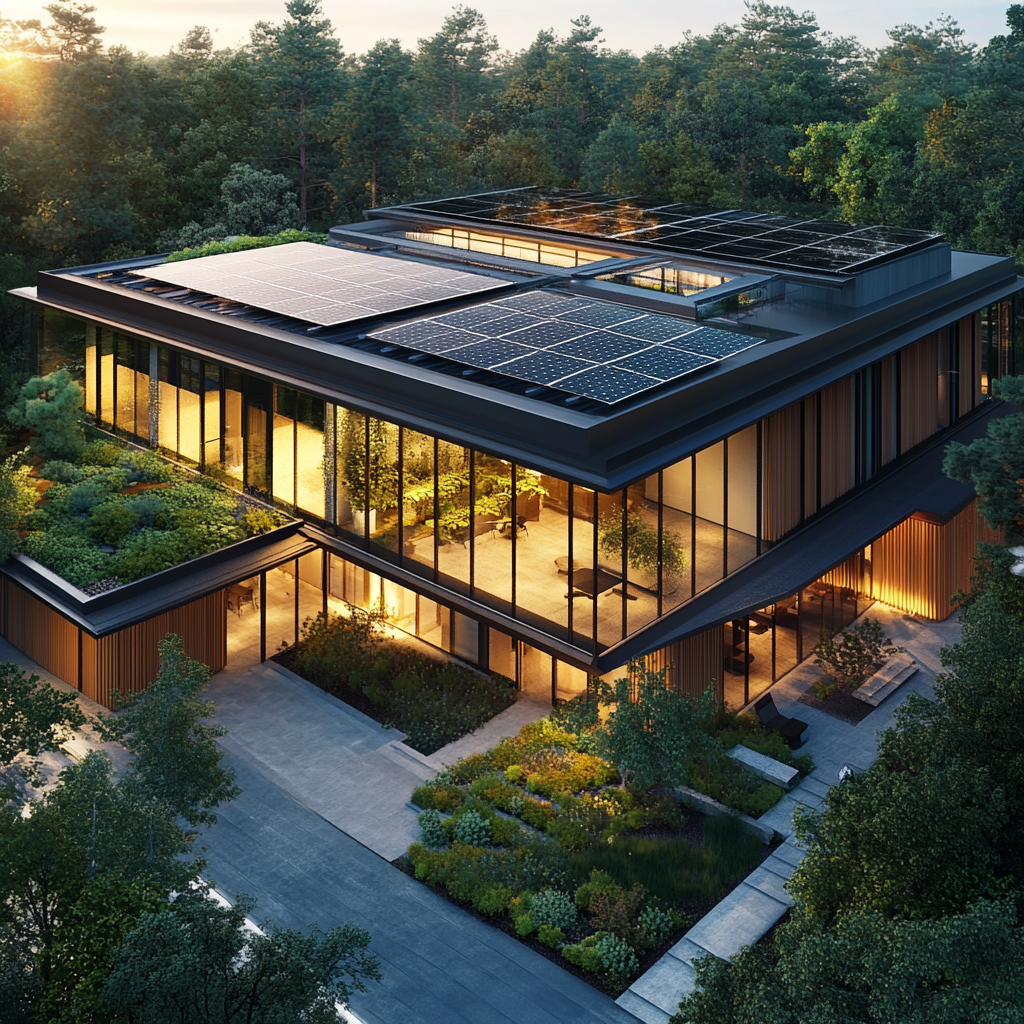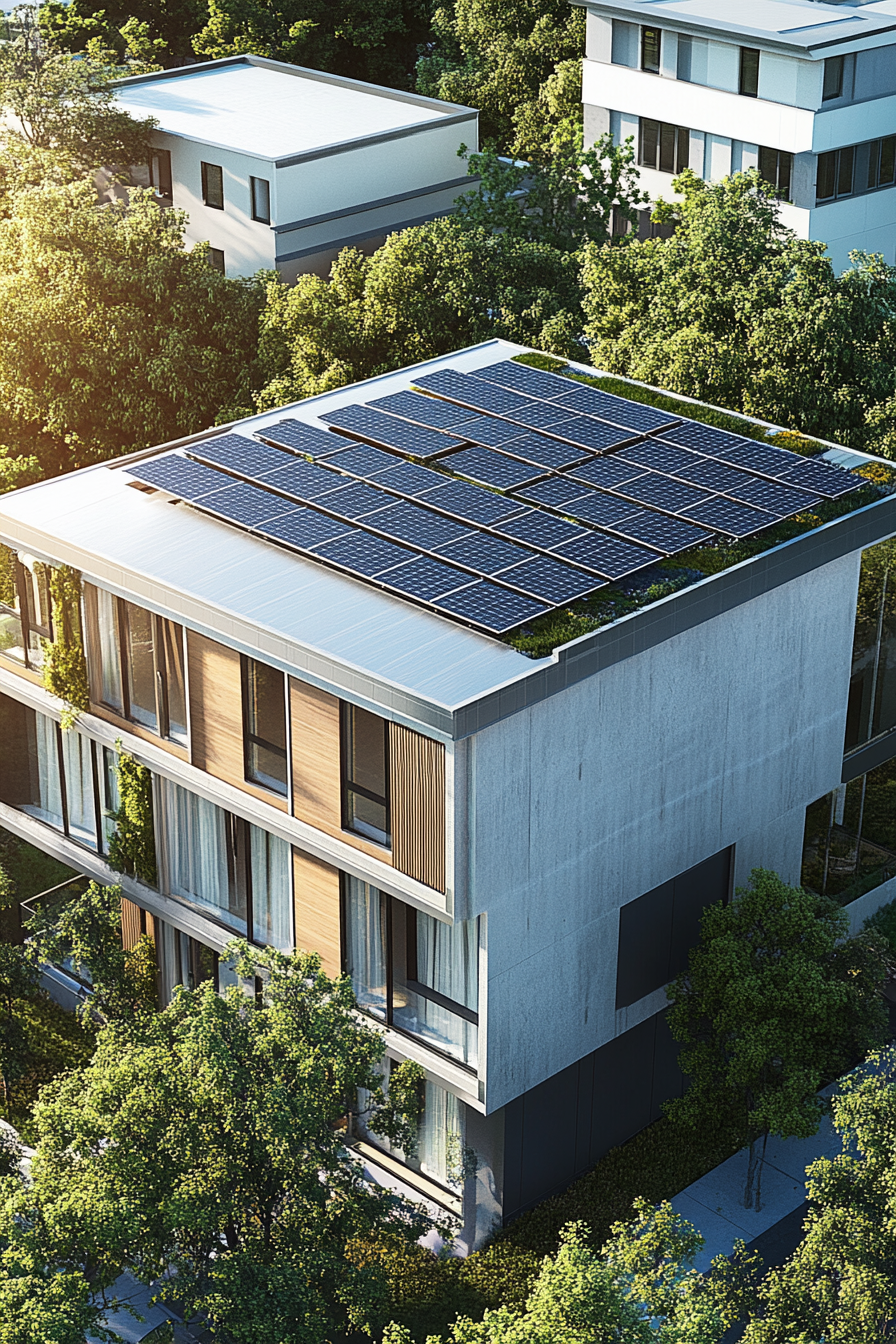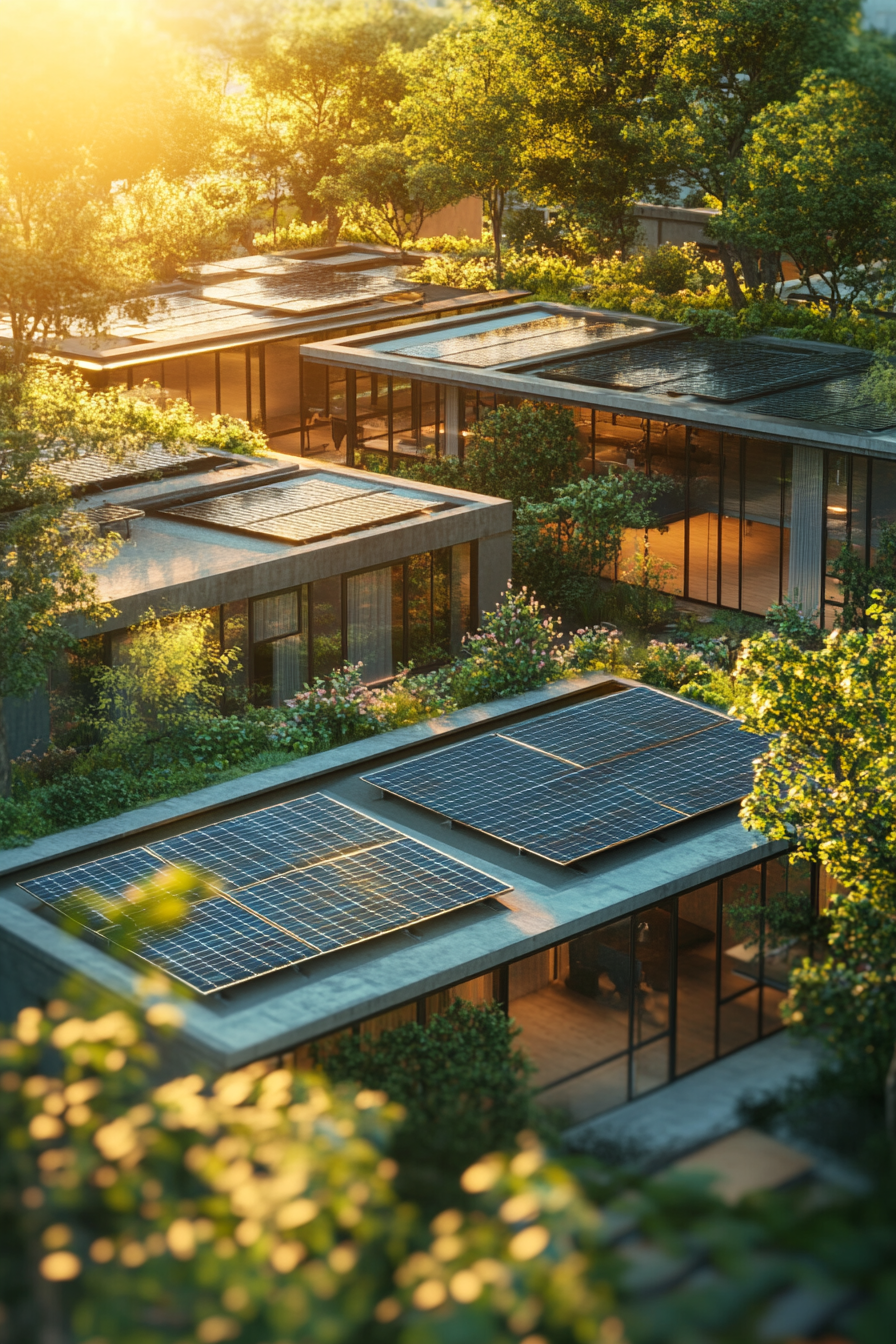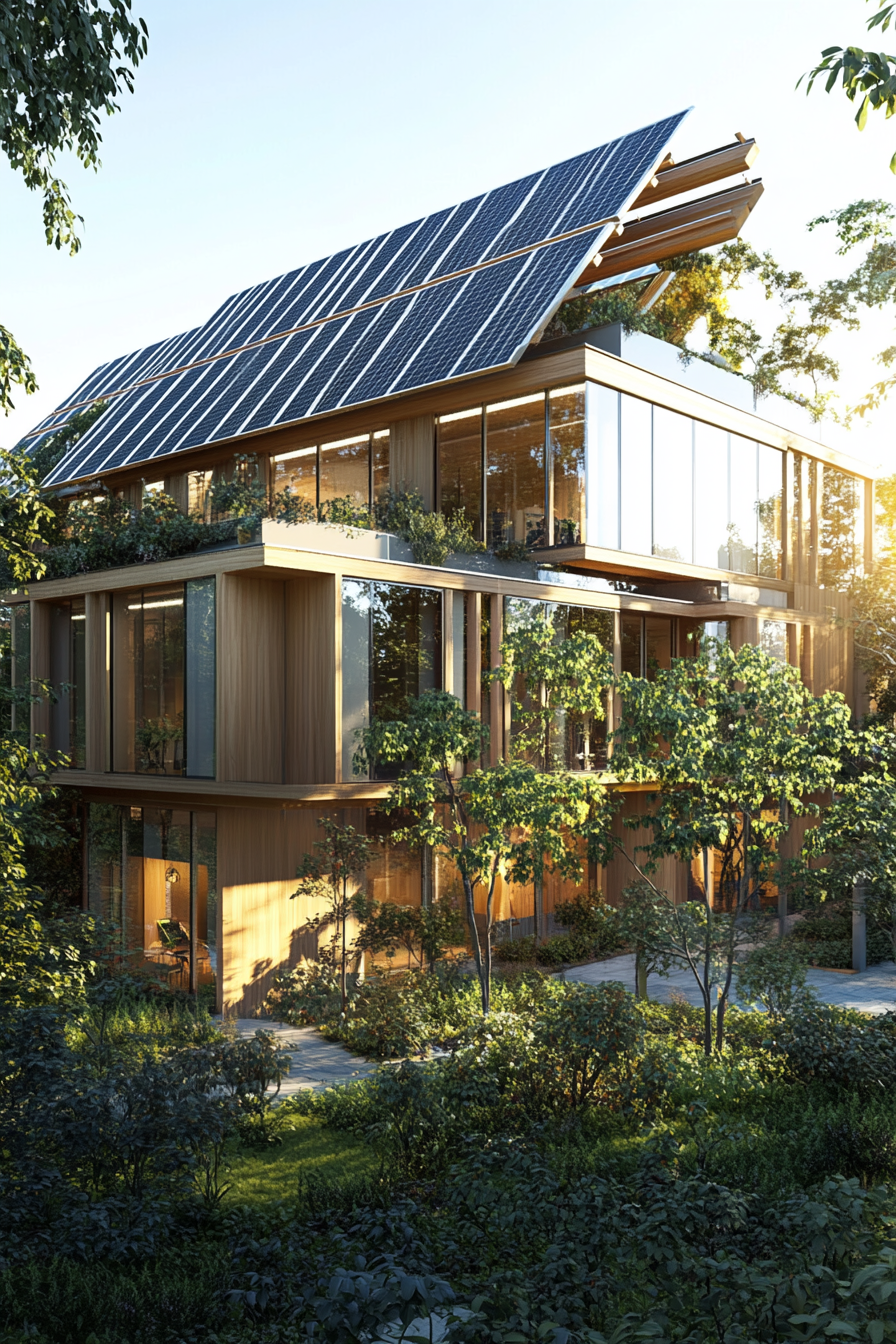Designing the Future, Sustainably.
Innovative, eco-conscious architecture that harmonizes with nature — creating spaces that are as sustainable as they are stunning
Eco-Conscious Designs
Sustainable Materials
Water Conservation

Architectural Design services
Revolutionizing Architecture with AI-Powered Innovation
From concept to creation, we blend cutting-edge AI technology with architectural expertise to design smarter, sustainable, and visionary spaces.
Types of Sustainable & Green Architecture We Offer
Passive Solar Design
Harnesses natural sunlight and airflow to reduce energy use, keeping interiors comfortable year-round with minimal mechanical heating or cooling.
Green Roof Architecture
Utilizes vegetated rooftops that improve insulation, manage stormwater, and enhance biodiversity in urban settings.
Earth-Sheltered Architecture
Incorporates building into the natural landscape, often underground or partially covered by earth, for superior thermal mass and low environmental impact.
Bamboo Architecture
Features fast-growing, renewable bamboo in structural and decorative elements—ideal for lightweight, flexible, and eco-friendly design.
Rammed Earth Construction
Uses compacted natural materials like soil and gravel to form durable, low-energy walls with a timeless, earthy aesthetic.
Net-Zero Energy Buildings
Designed to produce as much energy as they consume annually, these structures use renewable energy and energy-efficient systems.
Recycled and Reclaimed Material Design
Incorporates salvaged wood, brick, metal, and more to reduce waste and bring unique character to each project.
Modular and Prefab Green Buildings
Efficiently manufactured off-site, these buildings reduce construction waste and energy use while supporting sustainable scalability.
Living Wall Architecture
Vertical gardens on building exteriors improve air quality, regulate temperatures, and beautify urban environments naturally.
Smart Sustainable Homes
Integrate automation and green technology to optimize energy, water, and indoor air quality for a modern, efficient lifestyle.
Water-Efficient Landscape Design
Applies xeriscaping and native plant selection to conserve water and support local ecosystems with minimal maintenance.
LEED-Certified Buildings
Meet global sustainability benchmarks in energy, water use, materials, and indoor environmental quality, offering trusted eco-performance.
Simple, Streamlined Process
Share Your Plot
Upload plot size, facing, and requirements through our form
Review Concepts
We deliver the first layout within 48 hours
Make Revisions
Suggest changes – we revise accordingly
Receive Final Plan
Get your downloadable PDF files ready to use
See What We’ve Designed
Why Choose us
Blending AI-Powered precision with design excellence, we create smart, sustainable, and future-ready spaces tailored to your vision.

Tailor-Made Designs
Custom floor plans to fit your space and needs

Approval-Ready Layouts
Built for municipal and builder compliance

Expert Team
Designed by architects & planners

Faster Turnaround
Get plans within 7–10 working days
10000+ Floor Plans are ready to help.
Testimonials
Our customers love us, find out why below. 😍
Our customers trust us for quality, reliability, and exceptional service. the large number of possibilities.
Their architectural vision brought our dream to life with elegance and precision.
@Arun
3000Sq.ft
From design to execution, every element was crafted to perfection, making our space truly exceptional.
@Madhavan
1800Sq.ft
They didn’t just design a house; they created a timeless masterpiece that blends functionality with beauty effortlessly.
@Vignesh
2400sq.ft
A perfect fusion of creativity and practicality, making our space both aesthetically pleasing and highly functional.
@Hariharan & Family
4000sq.ft
Their expert guidance and innovative approach turned our ordinary space into an extraordinary architectural wonder.
@Priya
3000sq.ft
We are amazed by the seamless integration of modern design, natural elements, and functional living spaces they achieved.
@Jayanthi
1900sq.ft
Every line, angle, and space was thoughtfully designed to create a home that feels both luxurious and welcoming.
@Siva
2000Sq.Ft
Frequently asked questions
A sustainable house uses less energy, water, and materials while ensuring occupant comfort through natural ventilation, daylight, and efficient systems.
Yes! Smart planning and material choices help reduce long-term costs. Our solutions are scalable for any budget.
Absolutely. We offer renewable energy architecture solutions like solar panels, solar water heaters, and more.
Yes, our sustainable architecture consultancy services are tailored specifically for Indian climate zones and urban/rural site conditions.
Not at all! Green design enhances aesthetics with natural elements, modern materials, and elegant simplicity.
Sustainable and Green Architecture for Residential, Commercial, and Office Spaces
Sustainable and green architecture is revolutionizing the way we design buildings and living spaces. By prioritizing energy efficiency, low-carbon materials, and eco-friendly solutions, green architecture fosters environmental responsibility while creating healthier, more comfortable environments. Whether designing a residential home, commercial office, or mixed-use space, sustainable architecture provides long-term benefits, including cost savings, improved well-being, and a reduced environmental impact.
What is Sustainable Architecture?
Sustainable architecture involves designing buildings to reduce environmental impact while optimizing energy and resource efficiency. It incorporates green architecture principles by using eco-friendly materials, utilizing renewable energy, and ensuring the building’s long-term sustainability through low-carbon practices and environmentally conscious strategies.
Sustainable Architecture for Homes
Whether you’re building a new house or renovating an existing property, sustainable architecture is essential for creating an energy-efficient, environmentally responsible living space. By using green building design principles, homeowners can reduce their carbon footprint, save on energy bills, and live more comfortably.
Key Features of Sustainable Home Design:
- Energy-efficient designs: Integrating solar panels, passive solar design, and high-performance insulation.
- Eco-friendly materials: Utilizing low-carbon building materials like bamboo flooring, recycled steel, and non-toxic paints.
- Water conservation: Implementing rainwater harvesting systems and installing low-flow fixtures to minimize water usage.
- Natural lighting: Maximizing daylight harvesting through well-placed windows, skylights, and open layouts.
- Energy-efficient designs: Integrating solar panels, passive solar design, and high-performance insulation.
Sustainable and Green Architecture for Commercial Buildings
As businesses strive to meet sustainability goals, green architecture has become a key factor in commercial building design. Companies benefit from eco-friendly building materials, energy-efficient systems, and green certifications, such as LEED or BREEAM.
Key Considerations for Commercial Green Design:
- Energy-efficient systems: Installing high-efficiency HVAC units, solar panels, and smart lighting systems.
- Green roofs and walls: Incorporating living roofs to insulate the building and improve air quality.
- Sustainable materials: Using low-carbon materials like recycled concrete and sustainable timber.
- Water-saving features: Integrating rainwater harvesting systems and low-flow fixtures to reduce water consumption.
Sustainable Architecture for Office Spaces
Sustainable design in office spaces can lead to better productivity, health, and well-being of employees while lowering operational costs. Green office buildings are not only eco-friendly but also attract tenants who value corporate social responsibility.
Benefits of Green Office Architecture:
- Natural lighting: Create designs that enhance the flow of natural light, minimizing the dependence on artificial lighting during daylight hours.
- Indoor air quality: Incorporating non-toxic materials, low-VOC paints, and natural ventilation systems to enhance the quality of indoor air.
- Smart technology: Installing smart lighting and HVAC systems that optimize energy usage.
- Sustainable furniture: Choosing eco-friendly office furniture made from recycled materials or sustainable wood.
Urban Planning and Sustainable Development
Urban planning plays a critical role in sustainable architecture. By integrating green architecture principles into the urban fabric, cities can significantly reduce their environmental impact and promote a healthier living environment.
Key Aspects of Sustainable Urban Planning:
- Mixed-use zoning: Encouraging residential, commercial, and recreational spaces to be within walking distance, reducing the need for cars and lowering emissions.
- Public transportation: Designing neighborhoods with public transit access to minimize car dependence and reduce the carbon footprint.
- Green spaces: Creating parks, green roofs, and gardens to provide recreational areas, improve air quality, and reduce urban heat islands.
- Sustainable infrastructure: Using renewable energy sources, water recycling systems, and smart technology to create sustainable cities.
Sustainable Architecture: The Path Forward
Adopting sustainable architecture and green design principles is essential for creating a planet that future generations can enjoy and thrive on. By prioritizing energy efficiency, eco-friendly materials, and resource conservation, sustainable buildings not only lessen their environmental footprint but also offer healthier, more affordable living and working spaces.
Whether you’re building a new home, designing a commercial property, or planning an office space, sustainable architecture will help you achieve long-term value, lower operating costs, and meet environmental standards.
Reach out to Buildiyo today to see how we can help you integrate green architecture into your next project. Whether it’s for a home or commercial space, our team is eager to help turn your sustainable vision into reality.
Traditional vs. Modern Sustainable Architecture
Feature | Traditional Green Architecture | Modern Sustainable Architecture |
Design Focus | Energy conservation using simple methods | Advanced technology integration and smart materials |
Materials Used | Natural materials like wood, stone, and clay | Recycled, low-carbon, and renewable materials |
Energy Efficiency | Passive solar heating, natural ventilation | Smart HVAC systems, solar panels, wind turbines |
Urban Integration | Organic integration with landscape | Zoning, smart grid technology, mixed-use planning |
Both approaches emphasize sustainability but differ in the methods used and technology integrated. Modern green architecture involves sophisticated materials and energy systems that were not available in traditional designs.


